Now that Unstable has been fully revealed for a while, I want to take some time and examine one of the chief criticisms that came out against the set when it was announced: that of silver-bordered sets being unnecessary and not adding anything to the quote “real” game. Zach Barash even wrote an article about it here.
Basically the concern is this: Un-sets are supposed to explore new pockets of design that are crazy enough that black border can’t or won’t dive into without proof that they work. But if too much room is spent on cards that will never work in “real” magic—such as the artist matters cards from Unhinged or the ‘tear upon use’ artifacts from Unglued—design teams for future products haven’t gained anything.
Now, there’s certainly an argument that the fact those types of cards can never be done in black border is precisely why they should be done in silver border. But that’s not what I want to talk about today.
As a set, Unstable is actually in subject to some very unique circumstances. Because WotC was reluctant to print another Un-Set after the first two undersold, Unstable wasn’t released for several years after it went through design and development. That means that the cards we’ve been playing with for the past few years were designed after Unstable, and had the chance to draw from the craziness.
So just how many cards has Unstable inspired?
First, the timeline. From what I’ve been able to figure out, Unstable started design partially as a response to the success of Innistrad’s double-faced cards. Factor in roughly a year for the first drafts of Unstable to be fleshed out and another two before any of the inspired works could make it from design to print, and anything from Khans of Tarkir to the present is fair game.
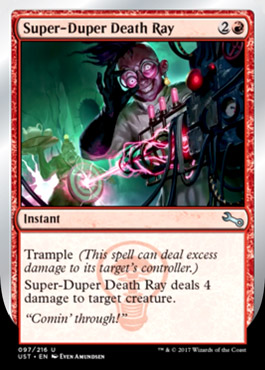
Maybe this was just me, but I remember when Soulfire Grand Master was previewed and my firth thought was simply: “you can do that?” Granting lifelink to the spells you cast is just so weird, so completely out of left field that I didn’t know what to think. At yet somehow, it just makes sense. It’s the exact same reaction I had to Super-Duper Death Ray. Now sure, giving lifelink to spells actually works within the rules and the same can’t be said of trample, but this was proof that combat keywords didn’t necessarily need to be for creatures only.
And yes, I’m well aware of Puncture Blast. But there’s a big difference between doing this with a brand new keyword that can still be tweeked and doing it with one that’s been in print for more than fifteen years.
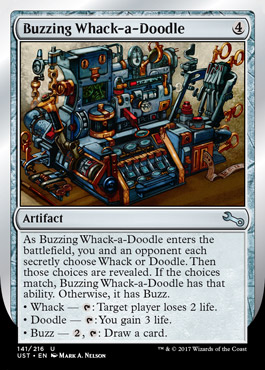
This one is easy to miss, but take a minute to appreciate how weird the template on Buzzing Whack-a-Doodle is. Where else have we seen different modes on a modal spell given names on the card itself? Outpost Siege comes to mind. There’s nothing that keeps it from working (other than the silly creative) and it even makes the card’s text take up less room because the different abilities can be referred to by name. As far as I can tell, this innovation actually opened up a whole new design space in the form of modal static effects, as in modal abilities that stay in effect once they’re chosen instead of being limited to triggered or activated abilities.
The Siege cycle from Fate Reforged mostly takes advantage of this template for flavorful reasons rather than mechanical ones, but they do prove this template works as-is in black border.
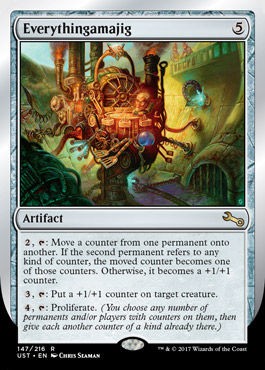
Admittedly the loosest connection on this list since Daghatar the Adamant doesn’t actually change the type of the counters he shuffles around and is limited both to creatures and a specific kind of counter. Even with those caveats, I believe that Daghatar is the first card able to repeatedly and directly move counters around, rather than needing to first convert them into some other resource like Ghave.
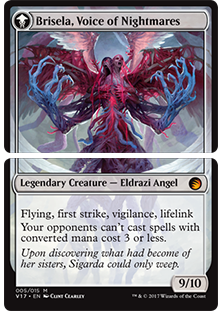
Easily the biggest mechanic to make the jump from Unstable, Meld might seem like an odd inclusion for this list. But there is now a Magic card named Half-Kitten, Half-. After all, it’s a much clearer riff on B.F.M. than it is on host and augment. However, the thing that I find significant about Meld is that it provides us with a template to make mix & match combination cards work. Imagine if all the double-faced creatures in a set were either left or right sides of larger creatures on the back side. All the right sides would have the host supertype or some other marker, and all the left sides would have text along the lines of:
“At the beginning of your upkeep, if you control one or more Hosts, exile ___ and one of them, then return them to the transformed and combined.”
Wordy, sure. But no more so than the text needed to make meld work. I don’t know if the split abilities from host and augment could ever work, but it doesn’t need to. Stapling Man-o’-Wars to Skyhunter Skirmishers would be plenty fun for me.
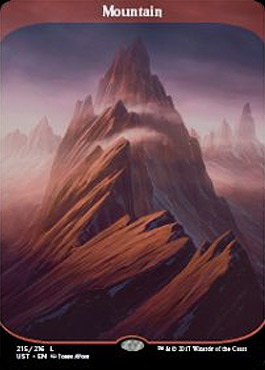
Un-sets don’t just exist to push the limits of design, but also the limits of technology. Before this past spring few people would’ve predicted that we could ever see Magic cards without traditional borders. (The reasons why have to do with the mechanics of the printing process, something I’m not really qualified to talk about.) Unstable found a solution to this, and while I doubt this is something WotC will use frequently, this opens up a huge number of options for what promo cards can look like going forward.
Personally I think the Amhonket Invocations look terrible, but a lot of people like them and I love how the Unstable Basics look. Not every crazy template will be for everyone, and that’s why I don’t expect some crazy full-art borderless look to replace the normal card frames anytime soon, but I’m looking forward to what the Masterpiece series and From the Vault will look like in five years.
That’s all of the connections that I was able to find, although some of the crazier ideas in Unstable are obvious attempts to gauge the playerbase’s response to their implementation before trying them out for real. I’m not going to try and guess if we’ll be seeing contraptions or other extra deck mechanics in four to five years, but at the very least it’s possible.
There is definitely future positional for a lot of Unstable’s ideas, but only time will tell how many of them go anywhere. Is that worth the cost of printing a set that can never be used in competitive play? I’d say yes, but that’s something we’ll all have to decide for ourselves. I just hope I’ve provided some context for these discussions going forward.
For my next article I’m hoping to do something a little different, so anyone who’s interested in building an Un-commander deck, email me at dearazami@gmail.com and I’ll see what kind of horrible contraptions (literal or otherwise) I can assemble.
Until then, embrace the insanity.
Levi Byrne has been with the game since Worldwake and has a rabid love for fantasy writing that goes back decades. Despite some forays into Legacy he plays Commander almost exclusively, and has a love for the crazy plays and huge games that make Magic what it is. He was the go-to advisor of his playgroup on deck construction for more than five years before joining Dear Azami.

